ROBOTS:
Robots may play an ever increasing role in our world. Many People tend to think of robots as the walking, talking, humanlike creations portrayed in science fiction movies, However, a robot in fact a mute, automatic machine, with electronic brains ( Micro-Processor) programmed to carry out specific tasks. Most robots are used in industry. For Example, nuclear scientists use robots to handle radioactive materials. In The 1980s Scientists also began to research the use of robots in routine medical surgery.
History Of Robots :
Leonardo's robot refers to a humanoid automaton designed by Leonardo da Vinci around the year 1495.
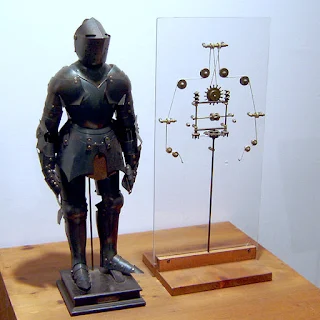 |
| Model of Leonardo's robot with inner workings, as displayed in Berlin. |
The design notes for the robot appear in sketchbooks that were rediscovered in the 1950s.Leonardo displayed his "robot" at a celebration hosted by Duke Sforza at the court of Milan in 1495. The robot knight could stand, sit, raise its visor and independently maneuver its arms. The entire robotic system was operated by a series of pulleys and cables. Since the discovery of the sketchbook, the robot has been built faithfully based on Leonardo's design; this proved it was fully functional, as Leonardo had planned. The robot is a warrior, clad in German-Italian medieval armour, that is apparently able to make several human-like motions. These motions included sitting up, moving its arms, neck, and an anatomically correct jaw. Also it was most likely planned to be made with fluidity in combat. It is partially the fruit of Leonardo's anatomical research in the Canon of Proportions as described in the Vitruvian Man.
Tipu Sultan`s Tiger or Tippoo's Tiger is an 18th century automaton or mechanical Robot Toy created for Tipu Sultan of India, the ruler of the Kingdom of Mysore in India. The carved and painted wood casing represents a tiger savaging a near life-size European man. Mechanisms inside the tiger and man's bodies make one hand of the man move, emit a wailing sound from his mouth and grunts from the tiger. In addition a flap on the side of the tiger folds down to reveal the keyboard of a small pipe organ with 18 notes.
 |
| Tipu's Tiger with the organ keyboard visible |
Uses of Robots:
Robots are most often used in difficult or dangerous situations to carry out tasks people wish to avoid. Many Factories use robots on the production line, beacuse they are unaffected by noise, heat and fumes in the workplace. Robots are also used by security forces in bomb disposal operations and in handling dangerous materials. Space probes are robots use to explore other planets.
1) Bomb Disposal:
A mobile robot like this is used by bomb disposal experts to check suspect objects. It is radio-controlled and moves on crawler tracks. It has TV-camera eyes and an adjustable arm with a grab attached for gripping.
 |
| Robot in Military Bomb-Squad |
2) Industrial Robots:
The car industry is a major robots for welding car components and Sparying paint. The robot is programmed to carry out its tasks quickly and accurately.
 |
| Robot-industrial |
3) Robot Explorers:
Space is a hostile place for humans to explore, but it suits robots involved in exploration . In 1976, American scientists sent two Viking probes to carry out a study of the Planet Mars, and search for signs of Life.
 |
| Mars-Rover, space robots are our most effective tool in space exploration. |
4) Rescue robot is a robot that has been designed for the purpose of aiding rescue workers. Common situations that employ rescue robots are mining accidents, urban disasters, hostage situations, and explosions. Rescue robots were used in the search for victims and survivors after the September 11 attacks in New York.The benefits of rescue robots to these operations include reduced personnel requirements, reduced fatigue, and access to otherwise unreachable areas.
 |
| rescue-robots |
 |
| Tokyo Institute of Technology's snake-like robot. It can search victim who get stucked in narrow places in broken buildings,train etc. |
How Industrial Robot Works:
A typical Industrial robot is a one-armed machine with flexible joints equivalent to the human shoulder, elbow, and wrist. It has a gripping mechanism that works as a hand. The robotic arm swivels on its supporting base, and may be moved electrically or pneumatically, by using compressed air. All movements are controlled by the robot`s computer brain.

A robot can be programmed to make a variety of movements: The arm can move in and out , be raised and lowered, and be swung from side to side.The hand can move in lots of diffrent ways too.
 |
| Space -Soldier Robot Toy Created by Me in 3D |
A powered exoskeleton (Wearable Robots): also known as powered armor, or exoframe, is a powered mobile machine consisting primarily of an exoskeleton-like framework worn by a person and a power supply that supplies at least part of the activation-energy for limb movement.
Powered exoskeletons are designed to assist and protect the wearer. They may be designed, for example, to assist and protect soldiers and construction workers, or to aid the survival of people in other dangerous environments. A wide medical market exists in the future of prosthetics to provide mobility assistance for aged and infirm people. Other possibilities include rescue work, such as in collapsed buildings, in which the device might allow a rescue worker to lift heavy debris, while simultaneously protecting the worker from falling rubble.
 |
| exo-wearable-robots |
Working examples of powered exoskeletons have been constructed but are not currently widely deployed.Various problems remain to be solved, including suitable power supply. However three companies launched exoskeleton suits for people with disabilities in 2010.
A fictional mech is different from a powered exoskeleton in that the mecha is typically much larger than a normal human body, and does not directly enhance the motion or strength of the physical limbs. Instead the human operator occupies a cabin or pilot's control seat inside a small portion of the larger system. Within this cabin the human may wear a small lightweight exoskeleton that serves as a haptic control interface for the much larger exterior appendages.
 |
| exo-wearable-robots |
A humanoid robot or an anthropomorphic robot: is a robot with its overall appearance, based on that of the human body, allowing interaction with made-for-human tools or environments. In general humanoid robots have a torso with a head, two arms and two legs, although some forms of humanoid robots may model only part of the body, for example, from the waist up
 |
| Humanoid Asimo Robot Created By me in 3D |
Purpose:
Humanoid robots are used as a research tool in several scientific areas.
Researchers need to understand the human body structure and behavior (biomechanics) to build and study humanoid robots. On the other side, the attempt to simulate the human body leads to a better understanding of it.
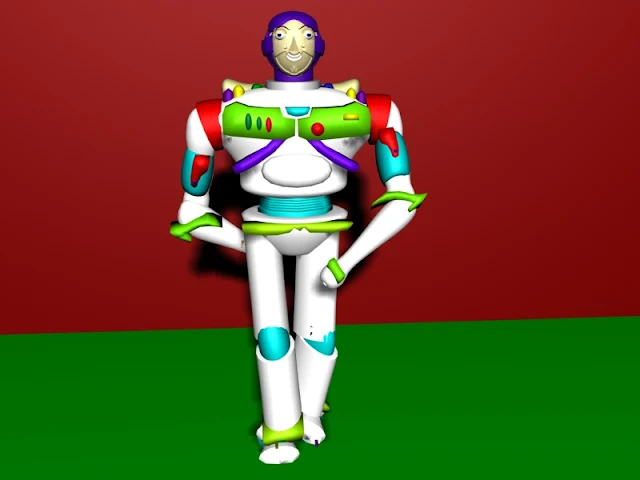 |
| Another Humanoid Walking Robot Created by me in 3D |
Human cognition is a field of study which is focused on how humans learn from sensory information in order to acquire perceptual and motor skills. This knowledge is used to develop computational models of human behavior and it has been improving over time. It has been suggested that very advanced robotics will facilitate the enhancement of ordinary humans.
 |
| ASIMO |
ASIMO by Honda, the world's most advanced humanoid robot, as well as other robotics technology by ASIMO Innovations.
An android is a robot: or synthetic organism designed to look and act like a human, and with a body having a flesh-like resemblance. Although "android" is used almost universally to refer to both sexes, and those of no particular sex, "Android" technically refers to the male form, while "Gynoid" is the feminine form. Until recently, androids have largely remained within the domain of science fiction, frequently seen in film and television. However, advancements in robotic technology have allowed the design of functional and realistic humanoid robots.
.jpg) |
| Actroid- DER 01, a Japanese actroid (Android Robot) |
The Intelligent Robotics Lab, directed by Hiroshi Ishiguro at Osaka University, and Kokoro Co., Ltd. have demonstrated the Actroid at Expo 2005 in Aichi Prefecture, Japan. In 2006, Kokoro Co. developed a new DER 2 android. The height of the human body part of DER2 is 165 cm. There are 47 mobile points. DER2 can not only change its expression but also move its hands and feet and twist its body. The "air servosystem" which Kokoro Co. developed originally is used for the actuator. As a result of having an actuator controlled precisely with air pressure via a servosystem, the movement is very fluid and there is very little noise. DER2 realized a slimmer body than that of the former version by using a smaller cylinder. Outwardly DER2 has a more beautiful proportion. Compared to the previous model, DER2 has thinner arms and a wider repertoire of expressions. Once programmed, it is able to choreograph its motions and gestures with its voice.
 |
| EveR-2, the first android that has the ability to sing. |
Isaac Asimov:
 |
| Isaac Asimov |
Science Fiction writer Issac Asimov (1920-1996) proposed three laws of robotics to allay fears that one day robots could " Take Over" . These are as follows:
1) Robots must not harm people, or allow them to come to any harm .
2) Robots must obey their orders, unless this conflicts with the first law
3) A Robot must protect itself unless this conflicts with the other laws.
Robots In the Home:
Robots are good at performing Simple, Repetative tasks that People find boring, such as washing-up and cleaning. However, such household jobs are actually quite complicated when broken down. Research is being carried out to make more sophisticated robots that have independent movement and careful co-ordination of " Mind" "Eyes" and "Hands".
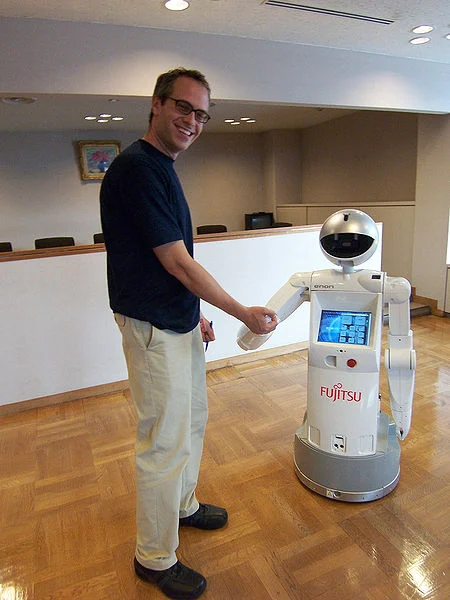 |
| Enon was created to be a personal assistant. It is self-guiding and has limited speech recognition and synthesis. It can also carry things |
Da Vinci Robot Surgeon :
The da Vinci System consists of a surgeon’s console that is typically in the same room as the patient and a patient-side cart with four interactive robotic arms controlled from the console. Three of the arms are for tools that hold objects, act as a scalpel, scissors, bovie, or unipolar or bipolar electrocautery instruments. The fourth arm is for an endoscopic camera with two lenses that gives the surgeon full stereoscopic vision from the console. The surgeon sits at the console and looks through two eye holes at a 3-D image of the procedure, meanwhile maneuvering the arms with two foot pedals and two hand controllers. The da Vinci System scales, filters and translates the surgeon's hand movements into more precise micro-movements of the instruments, which operate through small incisions in the body.
 |
| Full Picture of Da Vinci Robotic Surgeon System |
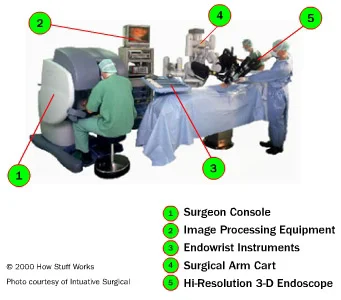 |
| Da Vinci Robot Surgeon System: Pictorial Description with labels |
According to the manufacturer, the da Vinci System is called "da Vinci" in part "because Leonardo da Vinci invented the first robot", and also because he used anatomical accuracy and three-dimensional details to bring his works to life.
 |
| Da Vinci Robot Surgeon During Operation |
To perform a procedure, the surgeon uses the console’s master controls to maneuver the patient-side cart’s three or four robotic arms (depending on the model), which secures the instruments and a high-resolution endoscopic camera. The instruments’ jointed-wrist design exceeds the natural range of motion of the human hand; motion scaling and tremor reduction further interpret and refine the surgeon’s hand movements. The da Vinci System incorporates multiple, redundant safety features designed to minimize opportunities for human error when compared with traditional approaches. At no time is the surgical robot in control or autonomous; it operates on a "Master:Slave" relationship, the surgeon being the "Master" and the robot being the "Slave."
The da Vinci System has been designed to improve upon conventional laparoscopy, in which the surgeon operates while standing, using hand-held, long-shafted instruments, which have no wrists. With conventional laparoscopy, the surgeon must look up and away from the instruments, to a nearby 2D video monitor to see an image of the target anatomy. The surgeon must also rely on his/her patient-side assistant to position the camera correctly. In contrast, the da Vinci System’s ergonomic design allows the surgeon to operate from a seated position at the console, with eyes and hands positioned in line with the instruments. To move the instruments or to reposition the camera, the surgeon simply moves his/her hands.
By providing surgeons with superior visualization, enhanced dexterity, greater precision and ergonomic comfort, the da Vinci Surgical System makes it possible for more surgeons to perform minimally invasive procedures involving complex dissection or reconstruction. For the patient, a da Vinci procedure can offer all the potential benefits of a minimally invasive procedure, including less pain, less blood loss and less need for blood transfusions. Moreover, the da Vinci System can enable a shorter hospital stay, a quicker recovery and faster return to normal daily activities.
The robot costs on average $1.3 million in addition to several hundred thousand dollars of annual maintenance fees. Surgical procedures performed with the robot take longer than traditional ones. Critics say that hospitals have a hard time recovering the cost and that most clinical data does not support the claim of improved patient outcomes.
Robots In science Fiction Movies:
The Science fiction robot was introduced in the play " Rossum`s Universal robots, Written by Czech playwright Karel Capek in 1921. The theme of human-like robots was developed in 1926 film Metropolis, which featured the divine Maria. More recent film goers would probably recognize the comedy Couple C3Po and R2D2 from the Star Wars Film. C3PO was an android, while R2D2 was more functionally built -its job was to carry out Repairs on spacecraft.

Among The Robot Movie " I Robot " was best according to me . Movie was about the Robot`s (Android: Human Like Robot) Revolution aganist the human race according The writer Isaac Asimov (Three Law of Robotics) due to the Ghost In the Machine. Then how Will Smith (Hero of the movie) Protect human race from the Robots was The Story.

Another Beautiful Movie about Robots was "Bicentennial Man" The Story about NDR series robot "Andrew" (Robin Williams) is introduced in 2005 into the Martin family home to perform housekeeping and maintenance duties. The family's reactions range from acceptance and curiosity to outright rejection and deliberate vandalism by their surly older daughter, Grace (Lindze Letherman), which leads to the discovery that Andrew can both identify emotions and reciprocate in kind. When Andrew accidentally breaks a figurine belonging to "Little Miss" Amanda (Hallie Kate Eisenberg), he carves a replacement out of wood. The family is astonished by this creativity and “Sir” Richard Martin (Sam Neill) takes Andrew to his manufacturer, to inquire if all the robots are like him. The CEO of the company sees this development as a problem and wishes to scrap Andrew. Angered, Martin takes Andrew home and allows him to pursue his own development, encouraging Andrew to educate himself in the humanities.
The Movie end with the story of How a Robot Gradually Become Living Human with all Emotions, Death etc.
 |
| Robots In My COFFEE-HOUSE-ADDA Group |
New Technological Development in Robotic Technology Worldwide:
 |
| CLOSE ENCOUNTER WITH COOL ROBOTS. |
 |
| A receptionist Robot Produced by Japan`s Robot Maker KOKORO |
 |
| Honda`s Latest Version of The Asimo Humanoid Robot Has enhanced intelligence and hand dexterity |
 |
| The Legged squad support system is a dismounted War Fighter capable of Carring almost 45 Kilograms of Gear. |
 |
| Bandit is a Robot Designed to Engage with Children with Autism |
 |
| Professor Hiroshi Ishiguro of the university of Osaka with the Silicone Android he designed to resemble himself. |

























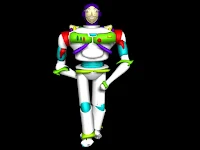

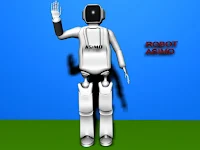
 Online Movies
Online Movies
You made some good points there.
ReplyDeleteI wanted to say that I have really enjoyed browsing your blog posts.
ReplyDeleteBig thumbs up for making such wonderful blog page!
ReplyDeleteTaking a few minutes and actual effort to produce a top notch article…
ReplyDelete
ReplyDeleteUsually I don't read post on blogs, however I wish to say that this write-up very impressived!!